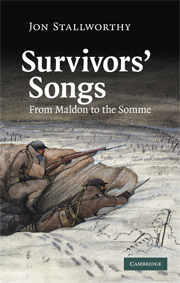Book contents
- Frontmatter
- Contents
- Voice over
- Acknowledgements
- 1 The death of the hero
- 2 Survivors' songs
- 3 England's epic?
- 4 Who was Rupert Brooke?
- 5 Christ and the soldier
- 6 Owen's afterlife
- 7 Owen and his editors
- 8 The legacy of the Somme
- 9 The iconography of the Waste Land
- 10 War and peace
- 11 The fire from heaven
- 12 Henry Reed and the Great Good Place
- 13 The fury and the mire
- Notes
- Index
8 - The legacy of the Somme
Published online by Cambridge University Press: 06 July 2010
- Frontmatter
- Contents
- Voice over
- Acknowledgements
- 1 The death of the hero
- 2 Survivors' songs
- 3 England's epic?
- 4 Who was Rupert Brooke?
- 5 Christ and the soldier
- 6 Owen's afterlife
- 7 Owen and his editors
- 8 The legacy of the Somme
- 9 The iconography of the Waste Land
- 10 War and peace
- 11 The fire from heaven
- 12 Henry Reed and the Great Good Place
- 13 The fury and the mire
- Notes
- Index
Summary
If you look at a British coin, what do you see? On one side, the realistic profile of a real Queen, and on the other, an imaginative representation of Britannia ruling the waves (until her proposed dethronement), a heraldic thistle or a heraldic rose. Here are two ways of looking at history: the one realistic, the other symbolic – but symbolic of what? Something other, older, and larger than the monarchy.
Historians are engaged in a search for the real – what really happened. They require imagination in reading the evidence and assessing probability where there is a gap in the evidence, but they require it less often and to a lesser degree than imaginative writers, dramatists, novelists, and poets. Historical evidence, historical writing, however, cannot alone account for the perception of historic events in a country's cultural history. Take, for example, the sack of two cities: Constantinople in 1453, and Troy in the Bronze Age. Two historical events: the first, of greater historical importance; the second, of greater cultural importance. Homer gave us Troy in a poem more often and more widely translated than any other book apart from the Bible; a poem that has inspired other poems, plays, paintings, sculpture, operas, novels, films. Why? Because Troy has come to stand for, to symbolize, more than itself. Homer's account contains all the archetypes of heroic literature, decked out in the primary colours of romance: Love, Lust, Ambition, Courage, Cruelty, Cunning.
- Type
- Chapter
- Information
- Survivors' SongsFrom Maldon to the Somme, pp. 98 - 108Publisher: Cambridge University PressPrint publication year: 2008
- 1
- Cited by



